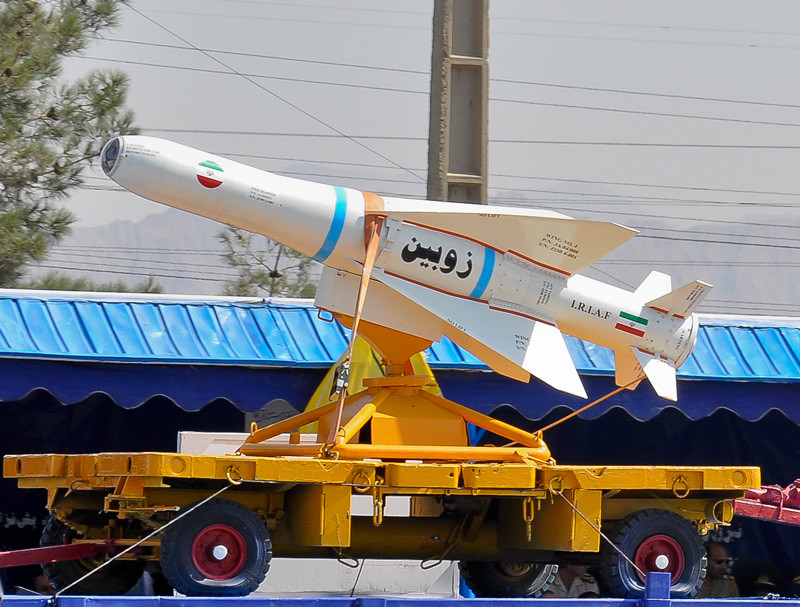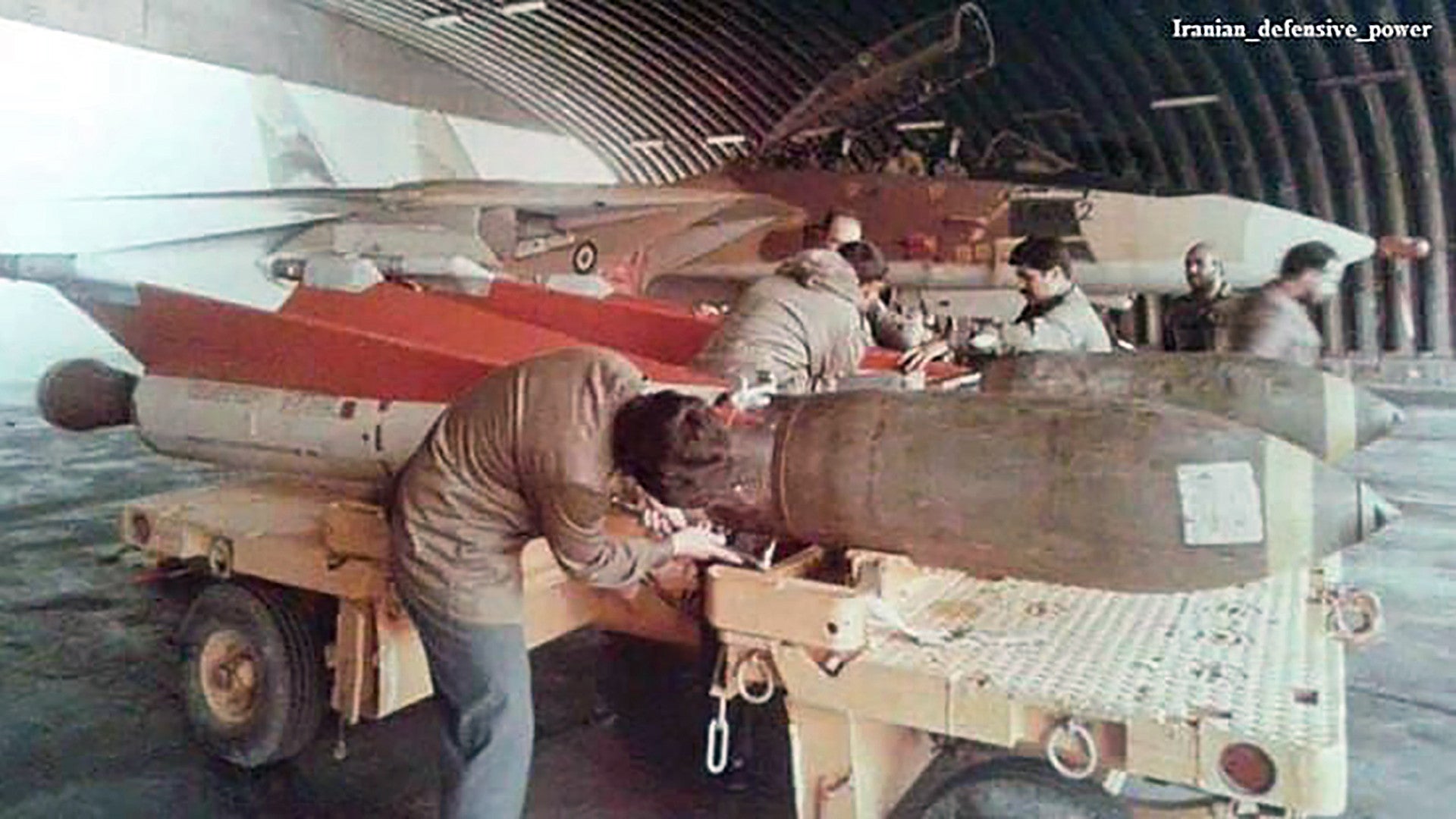The current regime in Iran is well known for repackaging and repurposing aircraft, weapons, and other military equipment that the United States supplied to the country when it was under the rule of Shah Mohammad Reza Pahlavi. Some of the earliest and most novel efforts took place during the brutal Iran-Iraq War, including the combination of elements of the MIM-23 Hawk surface-to-air missile and the 750-pound class M117 bomb to create an air-to-surface weapon called Yasser for the Iranian Air Force’s F-14A Tomcats.
Development of the Yasser began toward the tail end of the Iran-Iraq War, which lasted from 1980 to 1988. Iran’s desire for a stand-off air-to-surface weapon would have made good sense as Iraq continued to bolster its air defense capabilities during the conflict. While the Shah had obtained thousands of AGM-65 Maverick air-to-surface missiles in the 1970s, the Iranian Air Force’s stocks had begun to run low as the fighting dragged on.
Shortages of American-supplied missiles had already prompted Iran to experiment with converting MIM-23 missiles into air-to-air weapons for the F-14 as an alternative to the AIM-54 Phoenix as part of a project called Sky Hawk. In the end, some of Iran’s Tomcats were modified to carry one of the large missiles on each of their two wing glove hardpoints, where were more commonly occupied by AIM-7 Sparrow air-to-air missiles.

Testing of the air-to-air Hawks, which Iran dubbed Sedjils, uncovered a number of issues. The F-14A’s then-state-of-the-art AN/AWG-9 fire control radar was never meant to work with the MIM-23 and getting the two systems to work together proved problematic. There were also concerns about whether the Sedjil might severely damage the Tomcat launching it.
Ultimately Iran did conduct tests the Sedjils in 1986 and converted a relatively small number of MIM-23s into these air-to-air weapons, but their use was equally limited. Iran also continued to use its increasingly limited supply of AIM-54s and also managed to bolster its stocks of those weapons somewhat thanks to the Iran-Contra scandal. Much more recently, in 2017, Iran claimed to have created a domestic derivative of the Phoenix, called the Fakour-90.

The first tests of Yasser followed relatively soon after those of Sedjil. From what is known, the air-to-surface weapon was created by simply removing the nose section of the MIM-23 and replacing it with a modified M117 gravity bomb with its tail fins removed. F-14s could carry two Yassers in the same manner as the Sedjils.


Though described as an air-to-surface missile, it’s not clear how, or even if, Yasser was actually guided. The semi-active radar seeker in the Hawk – a name that is actually an acronym standing for Homing All the Way Killer – was clearly removed as part of the conversion process.
Some contemporary pictures, seen in the Tweet below, show Yassers with modified tail fins, which could point to some kind of beam-riding guidance system, whereby the F-14A’s radar might lock onto a target on the ground and then steer the missile toward it. Iran may have also been able to leverage the Hawk’s existing analog autopilot as a crude way of guiding it toward the general target area.
Another option would have been a type of crude command radio guidance, where the crew would physically steer the missile toward its mark. This is a guidance concept used in many early-generation air-to-surface missiles, including the late 1950s-era U.S. AGM-12 Bullpup.
There is the possibility that it could have been employed as a large unguided rocket, as well. That might have offered a means of attacking large and stationary, but critical targets, such factories, power plants, and similar structures, at close range.
By all accounts, guided or not, the accuracy of the Yasser was very poor and its use was very limited, with only a few reported operational launches. The weapons did offer a longer overall range than the AGM-65, being reportedly able to hit targets between 12.5 and almost 15 miles away.
Exactly what happened to any remaining Yassers, as well as Sedjils, after the end of the Iran-Iraq War is unclear. Iran revisited the Sedjil idea in the 1990s or has kept some of the earlier converted missiles inventory, but there is no indication that it has ever fielded them on any widespread basis. What appears to be an official Iranian Ministry of Defense video, which was posted on YouTube in 2016 and seen below, does show an F-14 carrying a Sedjil indicating that those weapons remain available for use, or at least did so until relatively recently, if necessary.

Yassers, or mockups thereof, continued to appear at military parades for decades, with one appearing at an event to mark the 25th anniversary of the end of the Iran-Iraq War in 2013. It’s not clear if this means the weapons have been or are still available for use operationally. Iran’s F-14A fleet, which has become ever more difficult to operate and maintain over the years due to U.S. sanctions, would be the only launch platforms for either of the MIM-23B-based weapons, greatly limiting their utility in any future conflict.
In addition, Iran has developed a number of precision-guided air-to-surface bombs and missiles, including the Zoobin, a television-guided missile that also uses a modified M117 bomb as its warhead. The Iranian Air Force also now has the Qadr and Qased, television-guided bombs that use 2,000-pound-class Mk 84 bombs as their warheads and are visually similar to the U.S. Air Force’s old GBU-8/B and GBU-15/B bombs, respectively. There is also a rocket-boosted version of Qased, a design akin to the U.S. Air Force’s AGM-130.

Whatever the fate of the remaining Yassers, Iran continues to reverse engineer and otherwise adapt American and other foreign-supplied weapons designs from decades ago to produce its own derivatives, some of which represent very practical capabilities, while claims about others can often be implausible, bordering on the ridiculous. Hawks, which Iran claims to have created a local derivative of called Shahin, remain in service as surface-to-air weapons, as well.

The Yasser is a prime example of the lengths Iran has gone to over the years to develop new and more advanced military capabilities locally in the face of sanctions that have limited its ability to source weapons and other equipment abroad. It’s a demonstration of both the ingenuity of the country’s defense industry and just how limited its resources have been in the past and still remain, in many respects, decades later.
Thanks to Twitter user @mhmiranusa for bringing the Yasser to our attention.
Contact the author: jtrevithickpr@gmail.com
